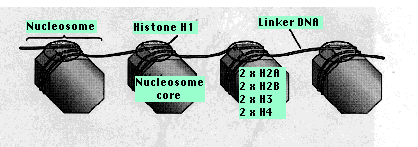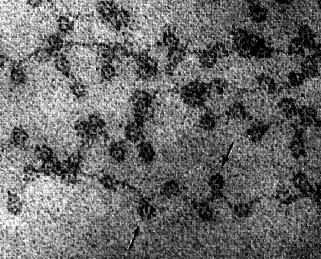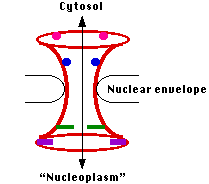Most of the protein consists of multiple copies of 5 kinds of histones. These are basic proteins, bristling with positively charged arginine and lysine residues. (Both Arg and Lys have a free amino group on their R group, which attracts protons (H+) giving them a positive charge.) Just the choice of amino acids you would make to bind tightly to the negatively-charged phosphate groups of DNA.
Chromatin also contains small amounts of a wide variety of nonhistone proteins. Most of these are transcription factors (e.g., the steroid receptors) and their association with the DNA is more transient. Two copies of each of four kinds of histones
Two copies of each of four kinds of histones
From 50-200 bp of DNA link one nucleosome to the next. Each linker region is occupied by a single molecule of histone 1 (H1).
The binding of histones to DNA does not depend on particular nucleotide sequences in the DNA but does depend critically on the amino acid sequence of the histone. Histones are some of the most conserved molecules during the course of evolution. Histone H4 in the calf differs from H4 in the pea plant at only 2 amino acids residues in the chain of 102.

This electron micrograph (courtesy of David E. Olins and Ada L. Olins) shows chromatin from the nucleus of a chicken red blood cell (birds, unlike most mammals, retain the nucleus in their mature red blood cells). The arrows point to the nucleosomes. You can see why the arrangement of nucleosomes has been likened to "beads on a string".
The formation of nucleosomes helps somewhat, but not nearly enough, to make the DNA sufficiently compact to fit in the nucleus. In order to fit 46 DNA molecules (in humans) averaging 5 cm in length into a nucleus that may be only 10 µm across requires more extensive folding and compaction. Lengths of nucleosomes are coiled together producing a compact fiber 30 nm in diameter. These fibers appear to be folded into a series of tight loops extending from a central protein scaffold.
During the period between cell divisions, when the chromosomes are in their extended state, 1 or more of them (10 in human cells) have loops extending into a spherical mass called the nucleolus. Here are synthesized three (of the four) kinds of RNA molecules (28S, 18S, 5.8S) used in the assembly of the large and small subunits of ribosomes. (The 5S rRNA molecules are synthesized at other locations in the nucleus.)
28S, 18S, and 5.8S ribosomal RNA is transcribed (by RNA polymerase I) from hundreds to thousands of tandemly-arranged rDNA genes distributed (in humans) on 10 different chromosomes. The rDNA-containing regions of these 10 chromosomes cluster together in the nucleolus.
Once formed, the rRNA molecules associate with the dozens of different ribosomal proteins used in the assembly of the large and small subunits of the ribosome.
But all proteins are synthesized in the cytosol - and all the ribosomes are needed in the cytosol to do their work - so there must be a mechanism for the transport of these large structures in and out of the nucleus. This is one of the functions of the nuclear pore complexes. The nuclear envelope is perforated with thousands of pores.
Each is constructed from ~100 different proteins.
The entire assembly forms an aqueous channel connecting the cytosol with the interior of the nucleus ("nucleoplasm"). When materials are to be transported through the pore, it opens up to form a channel some 25 nm wide - large enough to get such large assemblies as ribosomal subunits through.
The nuclear envelope is perforated with thousands of pores.
Each is constructed from ~100 different proteins.
The entire assembly forms an aqueous channel connecting the cytosol with the interior of the nucleus ("nucleoplasm"). When materials are to be transported through the pore, it opens up to form a channel some 25 nm wide - large enough to get such large assemblies as ribosomal subunits through.
Transport through the nuclear pore complexes is active; that is, it requires
All proteins are synthesized in the cytosol and those needed by the nucleus must be imported into it through the pores. Probably these proteins share a characteristic sequence of amino acids that targets them for entry.
They include:All the proteins leaving the nucleus had earlier been imported into it. Just how these proteins signal that it is time to exit (rather than enter) through the NPCs remains to be discovered.
In any case, all transport through the nuclear pore complexes is active; requiring a source of energy. Simple diffusion cannot do the job.
| Welcome&Next Search |